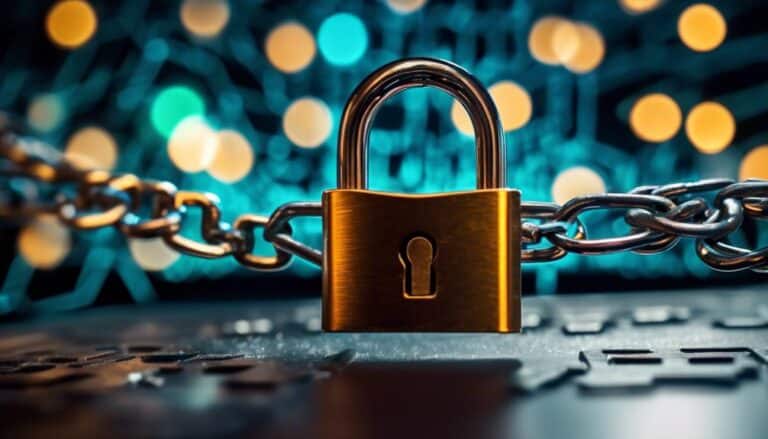Future-Proof Your Files: Adapting to the Evolving Landscape of Digital Security
In a world where technology advances at an unprecedented pace, the need to safeguard your digital files becomes more urgent with each passing day. As you navigate the ever-evolving landscape of digital security, it's crucial to stay one step ahead of potential threats.
But how can you ensure the safety of your files amidst an ever-changing landscape? Well, buckle up, because in this discussion, we will explore the essential strategies and emerging technologies that will future-proof your files and provide you with peace of mind.
So, are you ready to take control of your digital security?
Key Takeaways
- Robust digital security is crucial in today's interconnected world.
- Implementing cybersecurity best practices, such as regular data backups and encryption technologies, is essential.
- Strong passwords and authentication methods, along with educating yourself and your team on file security best practices, can help protect your files.
- Adopting encryption and secure file transfer protocols, such as SFTP and FTPS, can ensure secure transmission and storage of files.
The Importance of Digital Security

Ensuring robust digital security is of utmost importance in today's interconnected world, where cyber threats loom ever-present and evolving. With the increasing use of technology in our daily lives, digital privacy concerns have become a significant issue. Protecting your personal information and sensitive data from unauthorized access is crucial to safeguarding your privacy.
To achieve this, implementing cybersecurity best practices is essential. These practices encompass a wide range of measures designed to protect your digital assets and mitigate the risk of cyber attacks. This includes using strong, unique passwords for all your online accounts, regularly updating software and operating systems to patch vulnerabilities, and being cautious of suspicious emails and links.
Furthermore, it's crucial to use encryption technologies to secure your data both at rest and in transit. Encryption ensures that even if your data is intercepted, it remains unreadable to unauthorized individuals. Regularly backing up your data is also vital to prevent data loss in case of a security breach or hardware failure.
Understanding the Evolving Threat Landscape
To effectively protect your digital assets, it is crucial to understand the ever-changing landscape of cyber threats. Emerging cyber threats are constantly evolving and becoming more sophisticated, making it essential for individuals and organizations alike to stay informed and take necessary precautions. One of the most significant aspects of understanding the evolving threat landscape is gaining insight into data breaches.
Data breaches occur when unauthorized individuals gain access to sensitive information, resulting in potential financial loss, reputational damage, and even legal consequences. By understanding data breaches, you can better protect your digital assets and mitigate the risks associated with cyber threats.
Here is a table summarizing some key aspects of emerging cyber threats and data breaches:
| Emerging Cyber Threats | Understanding Data Breaches |
|---|---|
| Phishing Attacks | Types of Data Breaches |
| Ransomware | Common Vulnerabilities |
| Malware | Impact of Data Breaches |
| Social Engineering | Response and Recovery |
| Insider Threats | Preventive Measures |
Essential Strategies for Future-Proofing Your Files

Implementing robust security measures is essential for safeguarding your files against future threats. To future-proof your files, you need to have effective file backup strategies and data recovery options in place. Here are five essential strategies to consider:
- Regularly back up your files: Create a schedule to automatically back up your files to an external hard drive, cloud storage, or a network-attached storage (NAS) device. This ensures that you have a copy of your files in case of accidental deletion, hardware failure, or cyberattacks.
- Use encryption: Encrypting your files adds an extra layer of security by scrambling the data, making it unreadable without the encryption key. Use encryption software or tools to protect sensitive files, especially when storing them in the cloud or sharing them with others.
- Implement multi-factor authentication (MFA): MFA adds an additional layer of protection to your files by requiring multiple forms of authentication, such as a password and a fingerprint or a one-time code. This helps prevent unauthorized access to your files even if your password is compromised.
- Keep your software up to date: Regularly update your operating system, antivirus software, and other applications to ensure that you have the latest security patches and bug fixes. Outdated software can have vulnerabilities that cybercriminals can exploit to gain access to your files.
- Educate yourself and your team: Stay informed about the latest file security best practices and educate your team members on how to protect sensitive files. Train them on recognizing phishing attempts, using strong passwords, and avoiding suspicious links or downloads.
Implementing Strong Passwords and Authentication Methods
To enhance the security of your files, it's crucial to establish robust passwords and authentication methods that deter unauthorized access. One effective way to achieve this is by using password managers.
A password manager is a software application that generates and stores unique, complex passwords for your various online accounts. It encrypts and protects your passwords, ensuring that you don't have to remember them all. With a password manager, you can create strong, random passwords for each account without the risk of forgetting them or resorting to using weak passwords.
Another important authentication method to consider is two-factor authentication (2FA). This adds an extra layer of security by requiring users to provide two different means of identification, typically a password and a unique code generated by a mobile app or sent via SMS. This method significantly reduces the risk of unauthorized access, as even if someone manages to obtain your password, they'd still need access to your second factor, such as your phone.
Adopting Encryption and Secure File Transfer Protocols

To ensure the security of your digital files and data, it's crucial to adopt strong encryption methods and secure file transfer protocols.
Encryption helps protect your confidential information by converting it into a code that can only be deciphered with the appropriate decryption key.
Additionally, using reliable file transfer protocols ensures that your files are securely transmitted from one location to another, reducing the risk of unauthorized access or data breaches.
Strong Encryption Methods
Consider adopting strong encryption methods and secure file transfer protocols to enhance digital security. Protecting your data is crucial in today's evolving landscape of digital threats. Encryption techniques play a vital role in safeguarding your sensitive information from unauthorized access.
Here are five key reasons why you should prioritize strong encryption:
- Data Confidentiality: Encryption ensures that only authorized parties can access your data, keeping it confidential and protected.
- Data Integrity: Encryption techniques verify the integrity of your data, ensuring that it remains unchanged during transmission or storage.
- Authentication: Strong encryption methods provide authentication mechanisms, allowing you to verify the identity of the sender or recipient.
- Compliance: Implementing encryption techniques helps you meet regulatory requirements and industry standards for data protection.
- Secure File Transfer: Secure file transfer protocols, such as SFTP or HTTPS, ensure that your files are transmitted securely, minimizing the risk of interception or tampering.
Reliable File Transfer Protocols
Enhancing your digital security involves adopting reliable file transfer protocols that prioritize encryption and secure file transfer methods. When it comes to transferring files securely, it is crucial to choose a reliable file transfer method that ensures the confidentiality and integrity of your data. By using secure file transfer protocols, you can protect your sensitive information from unauthorized access and ensure secure data transmission.
One popular and widely used secure file transfer protocol is Secure File Transfer Protocol (SFTP). SFTP combines the encryption capabilities of Secure Shell (SSH) with reliable file transfer functionalities, making it a secure choice for transferring files over the internet. Another reliable option is File Transfer Protocol Secure (FTPS), which adds an extra layer of security by encrypting data using SSL/TLS protocols.
Below is a table comparing the features of SFTP and FTPS:
| Protocol | Encryption | Port | Authentication |
|---|---|---|---|
| SFTP | SSH | 22 | SSH key, username/password |
| FTPS | SSL/TLS | 21 | SSL/TLS certificate, username/password |
Staying Updated With Emerging Security Technologies
Are you aware of the latest emerging security technologies and how they can help protect your digital assets? In today's ever-evolving digital landscape, staying updated with emerging security technologies is crucial to safeguarding your valuable information.
By exploring biometric authentication and leveraging artificial intelligence in digital security, you can enhance the protection of your digital assets. Here are five key emerging security technologies you should be aware of:
- Biometric authentication: Biometrics, such as fingerprint or facial recognition, provide a more secure and convenient way to authenticate users, reducing the risk of unauthorized access.
- Artificial intelligence (AI): AI-powered security solutions can analyze vast amounts of data in real-time, detecting and responding to threats more efficiently than traditional methods.
- Blockchain technology: By using a decentralized and tamper-resistant ledger, blockchain technology ensures the integrity and confidentiality of digital transactions, making it harder for hackers to compromise sensitive data.
- Endpoint detection and response (EDR): EDR solutions monitor and respond to suspicious activities on endpoints, providing real-time threat detection and incident response capabilities.
- Cloud security: As organizations increasingly store and process data in the cloud, robust cloud security measures, such as encryption and access controls, are essential to protect against unauthorized access and data breaches.
To stay ahead of cyber threats, it's crucial to stay informed about these emerging security technologies and consider implementing them to bolster your digital security defenses.
Frequently Asked Questions
How Can I Protect My Digital Files From Cyber Attacks?
To protect your digital files from cyber attacks, use strong passwords, enable two-factor authentication, keep your software up to date, regularly back up your data, and consider using encryption for extra security.
What Are the Potential Risks of Not Prioritizing Digital Security?
Not prioritizing digital security puts your files at risk of data breaches and identity theft. Safeguarding your data is crucial to protect your personal information and prevent unauthorized access to sensitive data.
Are There Any Specific File Formats That Are More Vulnerable to Security Breaches?
Specific file formats like PDF and Microsoft Office documents are more vulnerable to security breaches. To secure your files, follow best practices like strong passwords, regular updates, and encryption. Stay aware of emerging threats and their impact on file formats.
How Can I Ensure That My Files Remain Secure Even as Technology Advances?
To ensure long term data integrity, balance convenience and security by regularly updating your security measures, using strong and unique passwords, encrypting your files, and keeping backups in multiple locations.
What Are Some Common Mistakes People Make When Trying to Secure Their Digital Files?
Common misconceptions when securing digital files include weak passwords, neglecting software updates, and not using encryption. Best practices involve using strong, unique passwords, regularly updating software, and implementing encryption tools for added protection.
Conclusion
In conclusion, future-proofing your files is crucial in adapting to the ever-evolving landscape of digital security.
By implementing strong passwords and authentication methods, adopting encryption and secure file transfer protocols, and staying updated with emerging security technologies, you can ensure the safety and integrity of your files.
Remember, digital security is an ongoing process that requires constant vigilance and proactive measures to protect your valuable data.
Stay informed, stay prepared, and stay secure.








